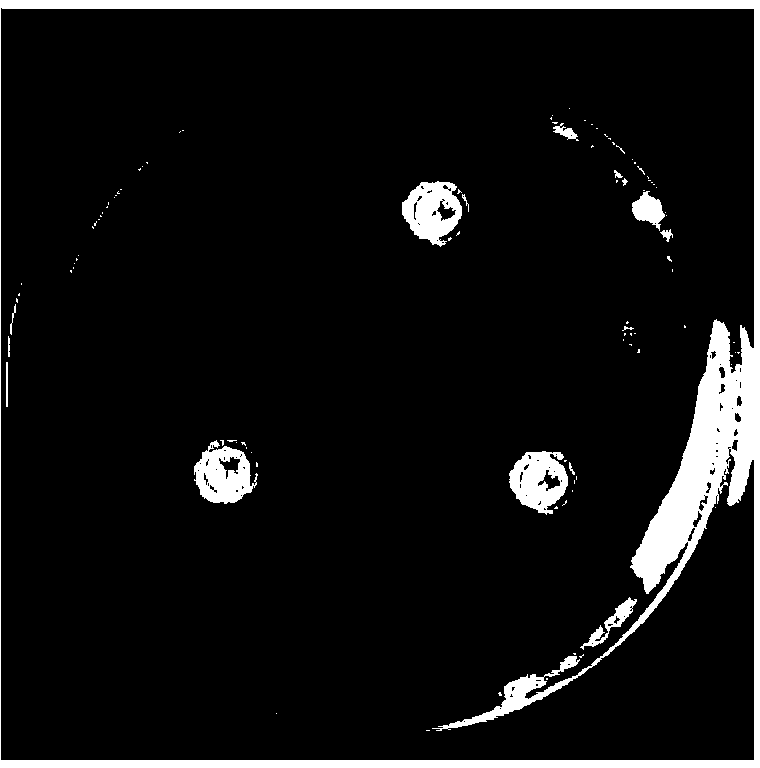Antagonistic bacteria S20 for controlling peanut bacterial wilt, organic microbiological fertilizer prepared thereby, and application
A technology of organic fertilizers and microorganisms, applied in the field of agricultural microorganisms, to achieve the effects of increasing income, reducing pesticide residues, and saving expenses
- Summary
- Abstract
- Description
- Claims
- Application Information
AI Technical Summary
Problems solved by technology
Method used
Image
Examples
Embodiment 1
[0027] Example 1 Isolation and Identification of Bacterial Strains
[0028] Ralstonia solanacearum (DSM No.9544), the pathogen of peanut bacterial wilt, was used as an indicator bacterium to isolate antagonistic bacteria from the rhizosphere soil of healthy peanut plants in Yingtan City, Jiangxi Province, where peanut bacterial wilt disease occurred. bacteria. Then through the pot experiment, the highly effective antagonistic strain S20 was finally screened out ( figure 1 ), the genus and species were identified, belonging to Bacillus amyloliquefaciens (Bacillus amyloliquefaciens), and the strains were stored in 30% glycerol at -70°C. The antagonistic bacteria S20 was sent to the General Microorganism Center of China Microbiological Culture Collection Management Committee for preservation. The preservation date was August 15, 2011, and the preservation number was CGMCC No.5139.
[0029] Antagonistic bacteria S20, belonging to Bacillus amyloliquefaciens (Bacillus amyloliquefa...
Embodiment 2
[0030] Embodiment 2 Bacteria production
[0031] 1) The antagonistic bacteria S20 (CGMCC No.5139) strain is inoculated into the PDA culture medium for liquid fermentation production. The conditions for the fermentation production are: the initial pH range is 7.0-7.2, the culture temperature is 30°C, 170 rpm, and the fermentation is 48h After forming spores, the obtained S20 antagonistic bacteria fermentation broth contains bacteria or spores ≥ 5×10 9 a / ml;
[0032] The preparation method of the PDA culture medium used is as follows, taking the preparation of 1L medium as an example: Peel 200g of potatoes, cut into small pieces, put them in water and boil, boil for 30min, add 20g of ordinary sucrose to the filtrate after filtration, and dilute to 1000ml, adjust the pH value to 7.2-7.4, and sterilize at 121°C for 20min.
[0033] 2) Preparation of organic fertilizer (OF): use decomposed pig manure compost and amino acid organic fertilizer (product of Jiangsu Xintiandi Amino Aci...
Embodiment 3
[0036] Embodiment 3 field test
[0037] The experiment was carried out in the continuous cropping peanut field of Yingtan City, Jiangxi Province, and the following three treatments were set up, each with a distance of 150m 2 , repeated three times.
[0038] 1) CK (conventional fertilization)
[0039] 2) Use 75kg / mu microbial organic fertilizer
[0040] 3) Use 150kg / mu microbial organic fertilizer
[0041] Peanuts were planted at the beginning of May, and fertilization was carried out according to local routines (urea 20kg / mu, calcium magnesium phosphate fertilizer 40kg / mu, potassium chloride 20kg / mu), and microbial organic fertilizer was used as a base fertilizer at one time, and the insufficient N, P, K were supplemented with chemical fertilizers. Qi, to ensure the same nutrients for treatment and control. Harvest in mid-August. Investigate the occurrence of bacterial wilt at the maturity stage of peanuts, and calculate the control effect. The results showed that the biol...
PUM
 Login to View More
Login to View More Abstract
Description
Claims
Application Information
 Login to View More
Login to View More - R&D
- Intellectual Property
- Life Sciences
- Materials
- Tech Scout
- Unparalleled Data Quality
- Higher Quality Content
- 60% Fewer Hallucinations
Browse by: Latest US Patents, China's latest patents, Technical Efficacy Thesaurus, Application Domain, Technology Topic, Popular Technical Reports.
© 2025 PatSnap. All rights reserved.Legal|Privacy policy|Modern Slavery Act Transparency Statement|Sitemap|About US| Contact US: help@patsnap.com


